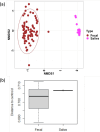Rapid shift of gut microbiome and enrichment of beneficial microbes during arhatic yoga meditation retreat in a single-arm pilot study
- PMID: 39939954
- PMCID: PMC11823196
- DOI: 10.1186/s12906-025-04783-4
Rapid shift of gut microbiome and enrichment of beneficial microbes during arhatic yoga meditation retreat in a single-arm pilot study
Abstract
Background: The human microbiome plays a vital role in human health, mediated by the gut-brain axis, with a large diversity of functions and physiological benefits. The dynamics and mechanisms of meditations on oral and gut microbiome modulations are not well understood. This study investigates the short-term modulations of the gut and oral microbiome during an Arhatic Yoga meditation retreat as well as on the role of microbiome in improving well-being through a possible gut-brain axis.
Methods: A single-arm pilot clinical trial was conducted in a controlled environment during a 9-day intensive retreat of Arhatic Yoga meditation practices with vegetarian diet. Oral and fecal samples of 24 practitioners were collected at the start (Day0: T1), middle (Day3: T2), and end (Day9:T3) of the retreat. Targeted 16S rRNA gene amplicon sequencing was performed for both oral and gut samples. Functional pathway predictions was identified using phylogenetic investigation of communities by reconstruction of unobserved states (PICRUSt2). DESeq2 was used to identify the differential abundant taxa. Various statistical analyses were performed to assess the significant changes in the data.
Results: Our findings revealed that Arhatic Yoga meditation together with a vegetarian diet led to changes in the oral and gut microbiome profiles within the 9-day retreat. Oral microbiome profile showed a significant (p < 0.05) difference in the species richness and evenness at the end of study, while non-metric multidimensional scaling (NMDS) confirmed the shift in the gut microbiome profile of the practitioners by T2 timepoint, which was further supported by PERMANOVA analysis (p < 0.05). Health-benefiting microbes known to improve the gastrointestinal and gut-barrier functions, immune modulation, and gut-brain axis were enriched. Gut microbiome of both beginner and advanced Arhatic Yoga practitioners showed similar trends of convergence by the end of study. This implies a strong selection pressure by Arhatic Yoga meditation together with a vegetarian diet on the beneficial gut microbiome.
Conclusion: This pilot study demonstrates that Arhatic Yoga meditation practices combined with a vegetarian diet during a short intensive retreat resulted in enrichment of known health-promoting microbes. Such microbial consortia may be developed for potential health benefits and used as probiotics to improve the gastrointestinal and immune systems, as well as functions mediated by the gut-brain axis.
Trial registration: Study was submitted in https://clinicaltrials.gov/on28-02-2024 . Retrospective registered.
Keywords: Arhatic yoga; Beneficial microbes; Clinical trial; Gut-brain axis; Meditation; Oral and gut microbiome.
© 2025. The Author(s).
Conflict of interest statement
Declarations. Ethics approval and consent to participate: Ethical approval (IRB No: 22–08-521–1247) was obtained from Pranic Healing Research Institute before the start of the study. Informed consents were obtained from the participants. Consent for publication: All authors have provided their consent. Competing interests: The authors declare no competing interests.
Figures








References
-
- Aziz Q, Doré J, Emmanuel A, Guarner F, Quigley EM. Gut microbiota and gastrointestinal health: current concepts and future directions. Neurogastroenterol Motil. 2013;25(1):4–15. - PubMed
-
- Tilg H, Moschen AR. Microbiota and diabetes: an evolving relationship. Gut. 2014;63(9):1513–21. - PubMed
-
- Zhang X, Zhao LD, Li H. The gut microbiota: emerging evidence in autoimmune diseases. Trends Mol Med. 2020;26(9):862–73. - PubMed
Publication types
MeSH terms
Substances
LinkOut - more resources
Full Text Sources

